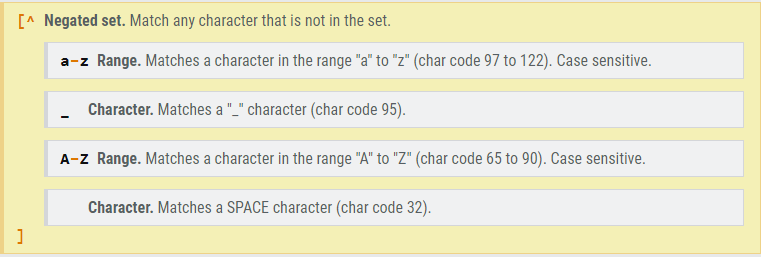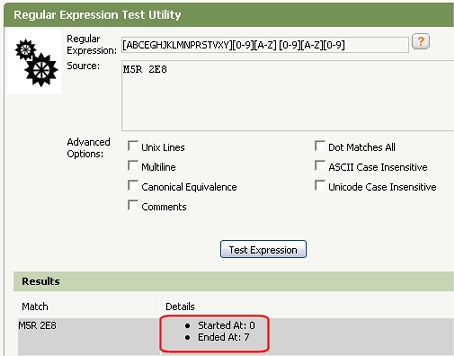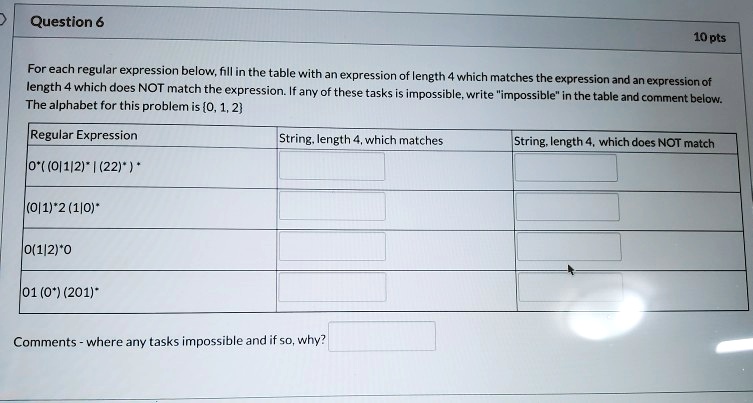

One of the most common things you'll do once you find a matching pattern is replace that pattern with something else.
REGULAR EXPRESSION NOT MATCH HOW TO
So now that you know how to match patterns in strings, you'll probably want to do something useful with those matches.

match() provides for a single match (index, the original string, and so on). matchAll() if you're using the g flag and want all the extra information that. While that just barely scratches the surface, keep in mind that it's probably better to use. match() const csLewisRepeat = "We We are are" Here's a simple example: const csLewisRepeat = "We We are are" ĬsLewisRepeat.match(repeatRegex) // matchAll() offers is that it works better with capture groups. While it seems like just a more complicated. matchAll() requires the global search flag ( g), and returns either an iterator or an empty array: const csLewisQuote = 'We are what we believe we are.' match() method which returns an array or null. matchAll() method was recently introduced. match() method, it's worth pointing out that the. Or if you want to preserve the original case, you could add the case-insensitive search flag ( i) to your regular expression: const csLewisQuote = 'We are what we believe we are.' match() method: const csLewisQuote = 'We are what we believe we are.'.toLowerCase() toLowercase() method on the string before testing it with the.

If you'd like all instances of the word "we" whether it's upper or lowercase, you have a couple of options.įirst, you could use the. In this case, you're matching a lowercase "w" followed by a lowercase "e", which only occurs twice. For example, say you wanted to see how many times the word "we" occurs in your string: const csLewisQuote = 'We are what we believe we are.' Case sensitivityĪn important thing to remember is that regex is case sensitive. You won't get the other information included with the non-global mode, but you'll get an array with all the matches in the string you're testing. To do that, just add the global search flag to your regular expression: const csLewisQuote = 'We are what we believe we are.' match() an array with the first match along with the index of the match in the original string, the original string itself, and any matching groups that were used.īut say you want to see how many times the word "are" occurs in a string. The first mode is when the global flag ( g) isn't used, like in the example above: const csLewisQuote = 'We are what we believe we are.' ĬsLewisQuote.match(regex) // match() returns had two different modes, for lack of a better term. match() is only matching the first occurrence of the word "are".Ī lot of times you'll want to know how often a pattern is matched against the string you're testing, so let's take a look at how to do that with. Some of you might have already noticed this, but if you look at the example above. We'll go into more detail about this in a bit. match() method will return an array with the match. There are two main return values you can expect from the. If all you want to know is if a search pattern is found or not, use the. This can be really helpful for some projects, especially if you want to extract and manipulate the data that you're matching without changing the original string. For example: const csLewisQuote = 'We are what we believe we are.' ĬsLewisQuote.match(regex1) // match() will actually return the match against the string you're testing. test() method which just returns true or false. So if regex is all about finding patterns in strings, you might be asking yourself what makes the. If you're brand new to regex and would like some practice before reading on, check out our interactive coding challenges. These patterns can sometimes include special characters ( *, +), assertions ( \W, ^), groups and ranges ( (abc), ), and other things that make regex so powerful but hard to grasp.Īt its core, regex is all about finding patterns in strings – everything from testing a string for a single character to verifying that a telephone number is valid can be done with regular expressions. In this tutorial, we'll go over the ins and outs of those methods, and look at some reasons why you might use them over the other included JS methods A quick introduction to regular expressionsĪccording to MDN, regular expressions are "patterns used to match character combinations in strings". replace() methods are probably the ones you'll use most often. JavaScript includes several helpful methods that make using regular expressions much more manageable. But they can be daunting, especially for beginning programmers. Regular expressions, abbreviated as regex, or sometimes regexp, are one of those concepts that you probably know is really powerful and useful.


 0 kommentar(er)
0 kommentar(er)
